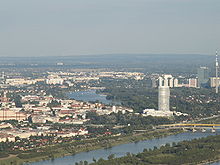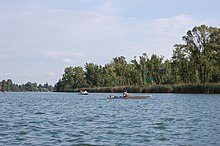Old Danube (Vienna)
| Old Danube | ||
|---|---|---|

|
||
| Old Danube looking towards Floridsdorf ; in the center of the picture is the underground line U1 | ||
| Geographical location | Vienna | |
| Tributaries | Groundwater and New Danube | |
| Drain | Groundwater | |
| Data | ||
| Coordinates | 48 ° 13 '56 " N , 16 ° 25' 40" E | |
|
|
||
| Altitude above sea level | 157 m above sea level A. | |
| surface | 1.56 km² | |
| length | 5.2 km | |
| width | 300 m | |
| volume | 3,700,000 m³ | |
| Maximum depth | 6.8 m | |
| Middle deep | 2.3 m | |


The Old Danube is an old arm of the Danube in Vienna . It is located orographically to the left (northeast) of the New Danube accompanying the main Danube river , but has no direct connection with either it or the Danube itself. The Upper Old Danube extends from the Floridsdorfer Bridge to the Kagran Bridge , the Lower Old Danube from the Kagran Bridge to the Donaustadt Bridge . A small part next to the Floridsdorfer Bridge is designed as a Floridsdorfer water park .
history
In the past, the Danube in the Vienna area branched out into many individual arms and channels and formed a wide, wild floodplain (see e.g. flagpole water ). The main stream changed its course again and again after floods, which made it impossible to build permanent bridges, as these were destroyed by almost every frequent ice surge . In the early 18th century, today's Alte Donau became the main arm of the Danube (also known as Floridsdorfer Arm ) after several devastating floods . In the course of configured as flood control regulation of the Danube (1870-1875) was the Old Danube separated from the newly dug today's main stream; Since then it has been an inland body of water with an area of around 1.6 km² and an average depth of 2.5 meters (maximum depth: 6.8 meters). The Old Danube is cut off from the immediate Danube water inflow and is mainly fed by the groundwater.
Ship mills used to stand in the area of today's Old Danube . In addition, the first Danube steamship in Austria, the Franz I, was built on its banks, and the seaplanes of the Lohner-Flugzeugwerke were tested on it.
Aquatic ecology
In the early 1990s, the algae load caused by over-fertilization was a major nuisance. The natural fluctuations in the groundwater level have been greatly reduced thanks to the relief channel (Neue Donau) that has now been built and the impoundment in the main stream, which was kept at a very even water level by the Freudenau power plant . Due to the disappearance of the groundwater dynamics, there was no longer a sufficient exchange of water in the Old Danube. This resulted in eutrophication of the water.
From 1996 a chemical water treatment was started in which the nutrient content in the water was broken down by phosphate precipitation by iron chloride and the decomposition of organic substances on the lake bed was promoted by adding calcium nitrate . In addition, measures for water pollution control were carried out in the area, such as an improvement in wastewater disposal in the surrounding areas.
Starting in 2002, further measures were taken to maintain the water quality after the chemical remediation. On the one hand, the water level has been lowered by 20 cm every spring since 2002 by draining water from the Old Danube into the Obere Lobau . This simulation of the earlier natural fluctuation of the groundwater level promotes the inflow of clean groundwater. In addition, since 2006, water has been transferred from the New Danube to the Old Danube for a few weeks every year. The discharge takes place at the lower end, the withdrawal and return in the area of the water park at the north end. This water exchange lowers the pH value of the Old Danube and at the same time improves the water quality in the water park.
Since these measures can only be applied for a limited period of time in the year, water from the New Danube is to be discharged from spring 2016 via a biological soil filter (similar to a plant-based sewage treatment plant ) that will be built in the water park. This is necessary because up to now a supply of water from the Danube was only helpful if its nutrient content was lower than that of the water in the Old Danube. In the soil filter, the nutrient content of the doping water is reduced and the calcium content is increased. The vertical flow system, which is being built on the south bank of the water park, has a size of 2,000 m² and a capacity of 90 l / s. By planting the filter bed with flowering water plants and a promenade with benches, the system is integrated into the landscape of the water park. The treated water can either be fed into the water park or directly into the Alte Donau. The water of the water park can also be directed over the filter in a pump-supported circuit.
Recreational use
Today the Old Danube is an important leisure and bathing area, thanks to the subway close to the city center. Several very popular public bathing beaches can be found on the banks, including the most famous of them, the Goose Hill .
Those who prefer a public bathing beach or a quiet bathing place will go to the Old Danube; But if you want something else - for example cycling or water skiing - you should look for a bathing place on the New Danube.
On the Old Danube you can rent rowing boats, sailing boats, pedal boats, electric boats or surfboards. It is well suited as a sailing area for beginners, but the surrounding high-rise buildings ( Donau City and UNO City ) can sometimes cause treacherous winds.
Some rowing clubs and associations use the Alte Donau for training purposes. In summer rowing regattas such as Vienna Nightrow are held on the Lower Old Danube .
See also
literature
- Karl Donabaum, Gerhard Nagel, Patricia Riedler: The Old Danube. Example of successful water management in the city of Vienna . In: Perspektiven (Vienna 2005), No. 2, pp. 46–51
- Gernot Ladinig (Ed.): The Old Danube. People by the water - perspectives of a Viennese landscape . Bohmann, Vienna 2000, ISBN 3-7002-1138-4
Web links
- MA 45 - The Old Danube
- EU project LIFE + Alte Donau
- Working group "The Beautiful Old Danube"
- European Sailing Information System - The Old and New Danube near Vienna
- ViennaSlide - Pictures of the Old Danube
Individual evidence
- ↑ Rehabilitation of the Old Danube in the 1990s , Internet publication by the Municipal Department of Vienna Waters (MA 45) ( memento of November 17, 2015 in the Internet Archive ), accessed on September 8, 2015
- ↑ Measures to maintain the water quality of the Old Danube , Internet publication by the Municipal Department of Vienna Waters (MA 45) ( Memento from November 21, 2015 in the Internet Archive ), accessed on September 8, 2015
- ^ Initial hydrological situation - Soil filter Alte Donau , Internet publication of the Municipal Department of Vienna Waters (MA 45) ( Memento from March 5, 2016 in the Internet Archive ), accessed on September 8, 2015
- ↑ How it works - Soil filter Alte Donau , Internet publication by the Municipal Department of Vienna Waters (MA 45) ( page no longer available , search in web archives ) Info: The link was automatically marked as defective. Please check the link according to the instructions and then remove this notice. , accessed September 8, 2015

